IMEHA (International Model Equine Hobbyists Association) was an online photo showing site that existing until 2018. Included on the site were these guidebooks for judging and showing model horses in Performance classes. MEPSA has obtained permission to share the info contained in the guides.
Scoring :: Point Deducts :: Tack :: Rider :: Reins :: Set-Up Options :: Photo Examples
A doll rider is required for this class. The rider is judged in this class on their ability to ride and control a horse properly without the use of a stock saddle. The rider shall be judged on their basic position: position of hand or hands, leg position, seat position and back position. To further explain, a rider should sit in a balanced relaxed manner, up close to the horse’s withers, keeping the back straight and shoulders even. The rider should keep their arms in close to the body. The rein hand or hands should be held loosely and should be positioned directly above and in front of where the saddle horn would be if the exhibitor were using a saddle. The position of the rider’s free hand is optional but should indicate a relaxed, not sloppy, balanced attitude of the body and should be kept free of the horse except that rider may hold a romal to keep it from swinging and to adjust the position of the reins provided it is held at least 16 inches from the reining hand. The legs maintain contact with the horse, giving the necessary leg grip. The foot is turned out slightly and the heels should be level or slightly lowered close to the horse just behind the horse’s elbows. The rider should be in balance with their horse at all times and should be able to sit the trot bareback. No posting at the trot will be permitted. An imaginary straight line drawn from the rider’s shoulders or hip should drop at the back of the heel and a straight line from the knee should drop in front of the toe. The rider set up in photo should readily convey their ability of how to handle a horse properly. The rider is penalized if they use two hands on the reins (except when riding a junior horse in an acceptable snaffle bit or hackamore/bosal), changes hands on the reins, or touches any part of the horse with their free hand. While the horse is in motion the rider’s hands shall be clear of the horse.
Photo may depict rail work consisting of any of the following gaits: walk, jog, lope, extended jog or lope, both directions in the arena. Or the horse may be shown performing the back-up or at a stop on the rail or in a line-up.
Photo may also depict any of the following individual works normally performed as a pattern individually in the center of the arena:
1. Back.
2. Walk, jog, trot, lope, in a straight line, curve or circle, or any combination of these gaits and patterns such as figure eights, etc.
3. Stop.
4. Turn on the haunches or forehand.
5. Side pass.
6. Simple lead change.
7. Flying lead change.
8. Counter canter.
9. Extended gaits.
For additional helpful hints for Western Pleasure or other disciplines please check out Susan Hargrove’s site at: Oh Joy Farms.
You Score Western Pleasure Gaits on the following:
The Walk:
(1) Poor walk – uneven pace and no cadence. Has no flow and may appear intimidated or appear to march.
(2) Average walk – has a four-beat gait, level top-line and is relaxed.
(3) Good walk – has a flowing four-beat gait, level topline, relaxed and is bright and attentive.
The Jog:
(1) Extremely poor jog – cannot perform a two-beat gait and has no flow or balance in the motion.
(2) Very poor jog – hesitates in the motion. Does not keep an even and balanced motion or a level top-line. May appear to shuffle.
(3) Poor jog – average motion but has negative characteristics such as; walking with the hind legs, dragging the rear toes or taking an uneven length of stride with the front and rear legs.
(4) Correct or average jog – has a two-beat gait, a level top-line and a relaxed appearance.
(5) Good jog – has an average motion with positive characteristics such as balance and self-carriage while taking the same length of stride with the front and rear legs.
(6) Very good jog – is comfortable to ride while having a consistent two-beat gait. The horse guides well, appears relaxed and has a level top-line.
(7) Excellent jog – effortless and very efficient motion. Swings the legs yet touches the ground softly. Confident, yet soft with its motion while being balanced and under control. Moves flat with the knee and hock and has some cushion in the pastern. Has a bright and alert expression and exhibits more lift and self-carriage than the “very good jog”.
Moderate Extended Jog:
(1) Poor extended jog – never lengthens the stride and may appear rough to ride.
(2) Average extended jog – moves up in its pace and appears smooth to ride.
(3) Good extended jog – has an obvious lengthening of stride with a slight increase in pace while exerting less effort and appears smooth to ride.
The Lope
(1) Extremely poor lope – does not have a three-beat gait. Has no flow, rhythm or balance. Uncomfortable to ride.
(2) Very poor lope – appears to have a three-beat lope but has no lift or self-carriage. The horse shuffles, has no flow and bobs his head, giving the appearance of exerting a great deal of effort to perform the gait. Also may appear uncomfortable to ride.
(3) Poor lope – has an average motion but exhibits negative characteristics like head bobbing, not completing the stride with the front leg and leaving the outside hock well behind the horse’s buttocks.
(4) Average lope – has a true three-beat gait with a level top-line and very little head and neck motion. He is relatively straight (not over-canted), guides well and has a relaxed appearance.
(5) Good lope – has an average motion but exhibits positive characteristics in his performance like self-carriage, a steady topline, relaxed appearance and is responsive to the rider’s aids.
(6) Very good lope – has more lift and flow than the average horse. He has a strong but smooth drive from behind. He may bend his knee slightly yet still has a level top-line while exhibiting self-carriage with a relaxed appearance. Appears comfortable to ride.
(7) Excellent lope – has a round back with an effortless strong, deep stride with the rear legs and a flat swing with the front legs. He keeps a level top-line, a relaxed yet alert and confident appearance and is correct but soft. A special horse with a great degree of lift and self-carriage.
The Back-Up:
(1) Poor back-up – is resistant and heavy in front. May gap the mouth and throw his head or back crooked.
(2) Average back-up – backs straight and quietly with light contact and without hesitation.
(3) Good back-up – displays balanced and smooth flowing movements. Backs straight with self-carriage without gapping the mouth with light contact and without hesitation.
Extra Credit Should Be Given If:
(1) Split reins are used, the rein should fall on the same side as the rein hand.
(2) A romal rein is used; romal should fall on the opposite side from the rein hand (romal is usually held in the rider’s other hand).
(3) Entry Number is shown on saddle blanket or on rider’s back.
Points Should Be Deducted If:
(1) Model exhibits excessive speed for gait assigned.
(2) Model is on the wrong lead.
(3) Model appears to display a slowness in any gait or loss of forward momentum resulting in an animated and/or artificial gait at the lope.
(4) Model’s head is carried too high.
(5) Model’s head carried too low tip of ear below the withers.
(6) Model is over flexed or has a strained neck in head carriage, so the nose is carried behind the vertical.
(7) Model displays excessive nosing out.
(8) Model displays an opening mouth excessively.
(9) Rider uses spurs forward of the heartgirth.
(10) Model appears sullen, dull, lethargic, emaciated, drawn or overly tired.
(11) Model appears agitated has ears back, tail twirled, etc.
(12) Model displays quick, choppy or pony strides.
(13) Reins are draped to the point that light contact is not maintained.
(14) Model is overly canted at the lope. *When the outside hind foot is further to the inside of the arena than the inside front foot.
Required Tack:
Silver should not be counted over a good working bridle and reins. A western style bridle (browband, one ear, two ear, with or without throatlatch) with a curb bit including a curb strap or curb chain. Standard snaffle bit and bosal hackamores are permitted on horses 4 and under (5 and under for Arabians and Appaloosas). Romal reins and split reins are both legal; Romal reins are usually seen on Arabians, Morgans, and NSH. Missouri Fox Trotters usually wear a noseband.
Prohibited Tack:
A Western saddle. Nosebands or cavessons (except: Missouri Fox Trotter and National Spotted Saddlebred/Walking Horse), roping reins, any kind of boots or bandages, crops or whips, mechanical hackamores are also prohibited. Split reins may not be knotted or attached to each other (stick wax is of course permitted in model horses) Rider may not have more than one finger between split reins or any fingers between the reins of a rein and romal.
Rider:
Attire is jeans, trousers or pants over western boots, long sleeved shirts, (vest, tie and jacket are also permitted) shotgun chaps, belt through loop, and western hat. The doll rider’s posture must be addressed because if you can’t get it correctly then don’t use it. Doll must sit down flat on horse’s back. The rider’s back should be straight. There should be a straight vertical line between the rider’s ear, the elbow and the heel. The knee and toe of the boot should also be in a straight line, knees and feet turned straight along the side of the horse and heel of boot pointed down. The rein arm upper arm should be tucked into the side of the rider, elbow is bent and the forearm parallel to the ground. The free arm is held free and straight down with palm flat and lightly touching the leg. You may place ONE finger between your split reins and there is no rule as to which one – though most riders place their index finger between. If using romal reins the romal hand is carried with hand holding romal at the length of which the romal is straight and not curved. Hand then rest quietly near or on the doll’s leg. Rein hand wrist(s) of either rein is turned slightly inward. The doll rider’s head should be looking straight forward as if rider is looking through the horse’s ears.
Rein Hand Holds:
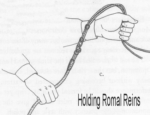

Rein Pull:
Horses are shown on a reasonable loose rein. Extremes such as too tight or too loose should be penalized.



Rider’s Western Bareback Position:
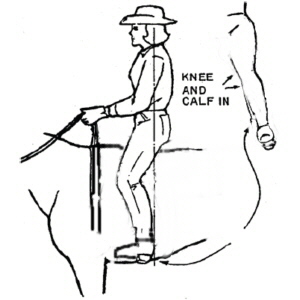
Set-Up Options:
Arena Fencing Required (Indoor or Outdoor Arena)
Types of Fencing Allowed:
- Painted or Natural
- Post and Rail
- Post and Plank
- Chain Link
- Solid Plyboard
- Plyboard with Top Rail
- Post with Drape Rope
- Stock Tube Pipe Rail
- Interior Arena Wall
Footing Required:
- Dirt
- Sand
- No grass base
- No rock base
Backboard or Natural Setting (Indoor or Outdoor)
Examples of the Four Breed Divisions:
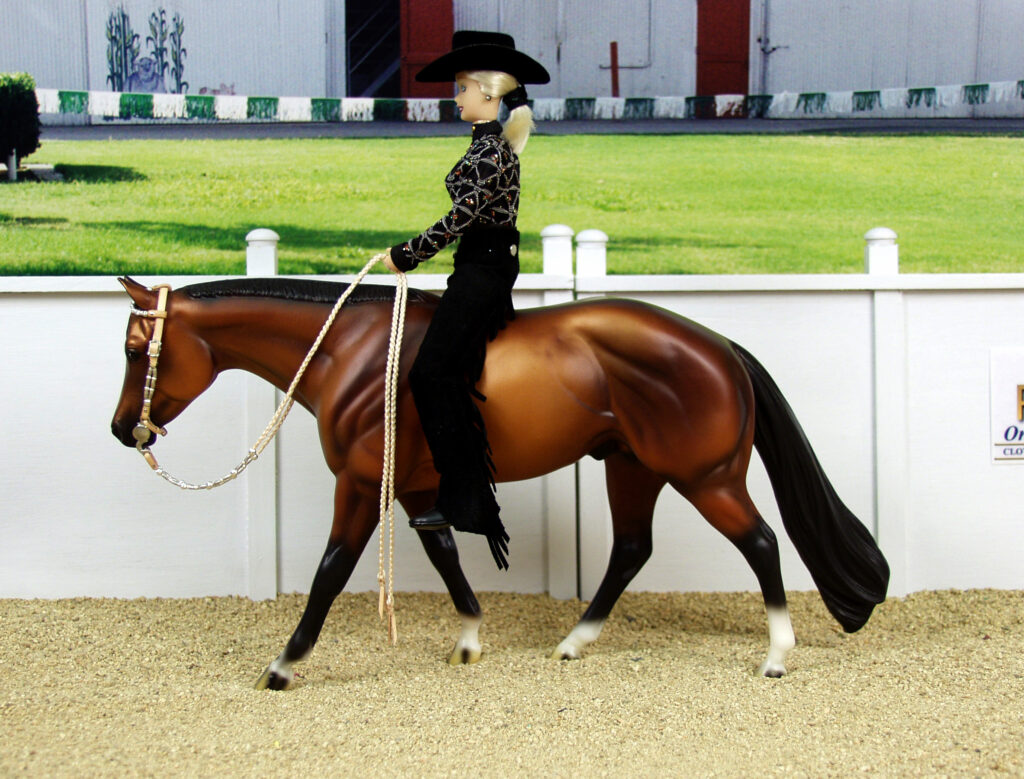
Western Bareback Equitation
Stock Breed Entry
OJF Zip N Zack OF Breyer. Owned and shown by Susan Hargrove. Note rider is using a correct hand hold on split reins and horse as a correct head set on the bit for a stock breed.
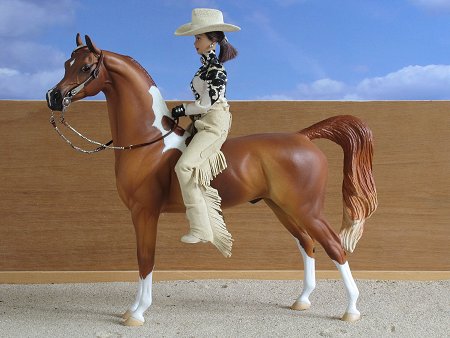
Western Pleasure
Arabian Breed Entry
Aer Kharysma shown as a chestnut tobiano Pintabian gelding, is a CM Peter Stone Arabian by Betsy Andrews. Owned and shown by Andrea Robbins.
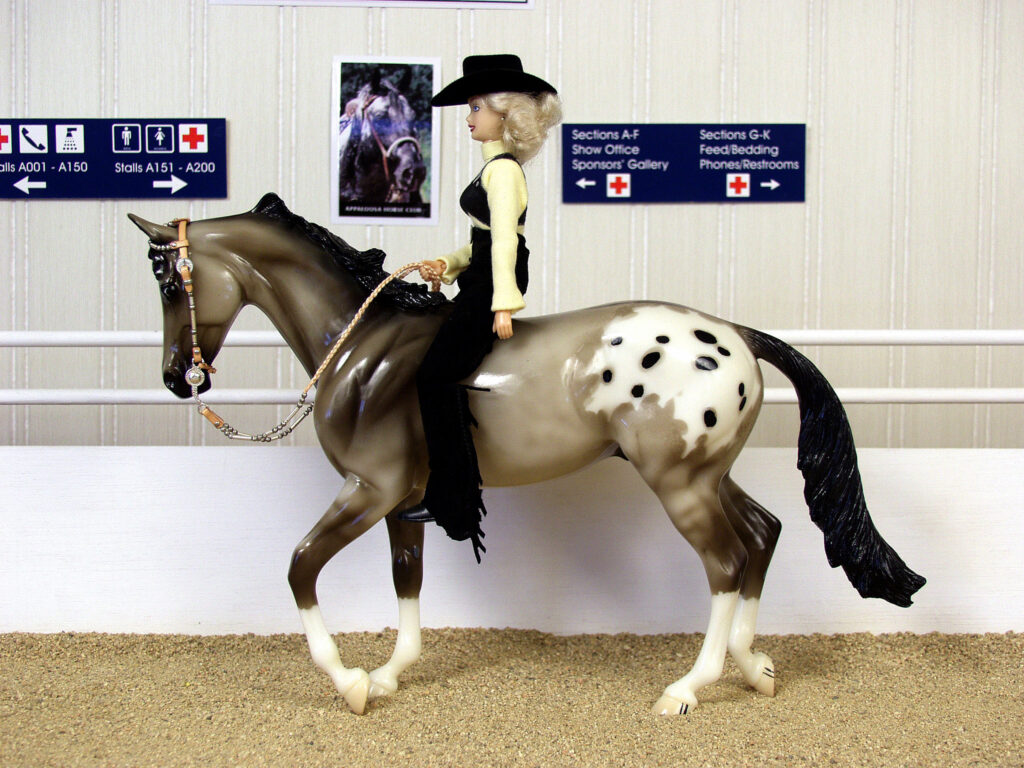
Western Bareback Equitation
TB/WB or Sporthorse Breed Entry
OJF Last Detail, shown as an Appaloosa Sporthorse, PS TB owned and shown by Susan Hargrove.

Western Pleasure
Other Breed Entry
Damiana Darling, shown as a bay roan Welara mare, is a Damiana resin painted by Katie Langford. Owned and shown by Andrea Robbins.
Hold the Reins Correctly:
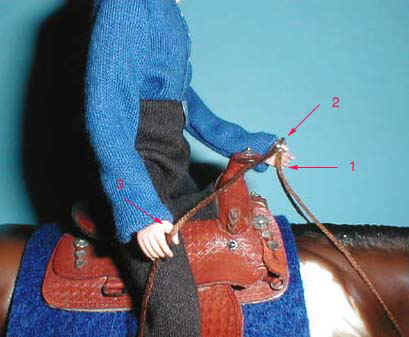
Romal Reins by Susan Hargrove
Romal reins enter the hand by the “little” finger lay across the palm of the hand and exit the hand on top over the thumb. The hand holds the reins and not the loop and knot that form the junction of the reins and the romal whip.
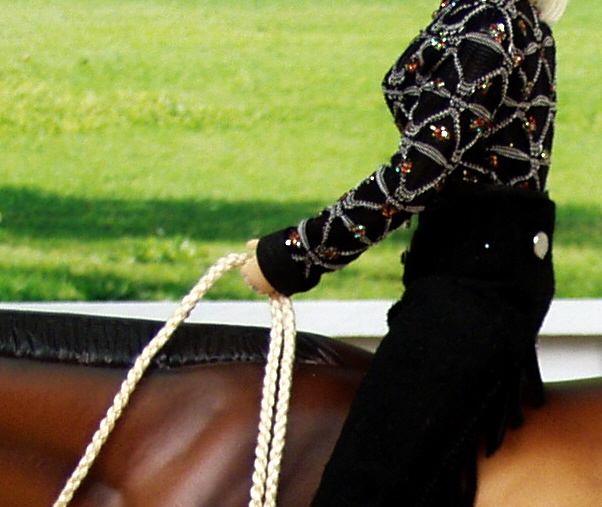
Split Reins by Susan Hargrove
Split reins can be held in the right or left hand. The excess rein hang over untouched on the same side of the horse. So if right hand hold the rein then the excess rein lies on the right side of the horse. If left hand holds the rein then the excess rein lies on the left side of the horse. Split reins enter the hand via coming straight into the hand over the index finger and they exit by the little finger.
